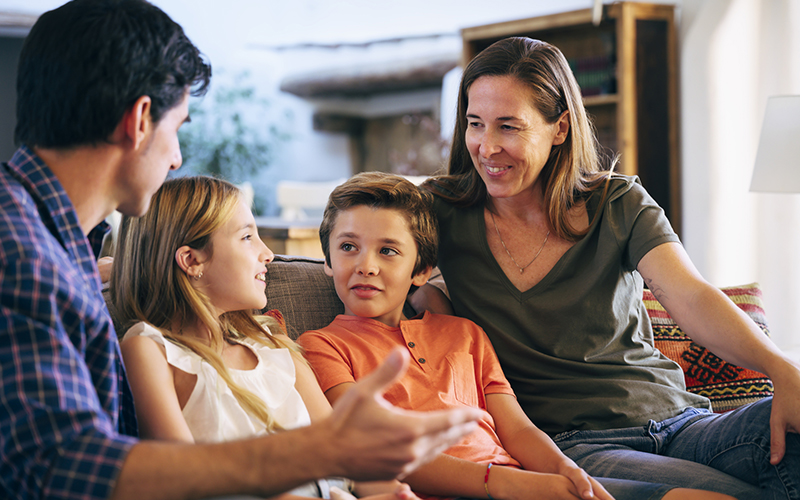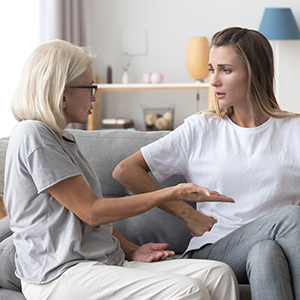How to Talk to Loved Ones about COVID-19

It can be difficult to get on the same page with loved ones about the measures we all should be practicing to stay safe during the pandemic. Use these expert strategies to share your concerns, find common ground, and set boundaries to keep you and your loved ones safe.
Remain calm
Talking about certain topics can instantly put us on edge despite our best intentions. But raised voices or a defensive stance not only won’t help matters – it could even make them worse and alienate you further from loved ones who don’t share your viewpoint. If you find yourself getting frustrated or heated, take a break.
Say something like “Can we come back to this in a few minutes? I’d like to take a few minutes to think about what you’ve said.” Otherwise, a conversation that ends poorly can leave the other person feeling not understood, heard, or validated.
Ask open-ended questions

Questions such as, “What worries you about COVID-19?”or “What’s been hardest for you during this pandemic?” give your loved ones a safe space to talk through their discomfort and deep-down concerns, which could ultimately lead to different conclusions on their end.
Share your feelings
It’s an act of love to show your concern about your loved one’s health. But how you share those feelings can immediately make or break the conversation. A large part of having a productive heart-to-heart involves vulnerability. Try not to shy away from how you’re feeling, but keep those feelings in your court rather than projecting or coming across in an accusing tone.
One key way to accomplish this is by leading with the words, “I am feeling” or “I feel” rather than “You are” or “Why are you….” This conversation starter can help foster a spirit of solid discussion rather than what may be perceived by the other person as an attack. Use the examples below to help guide you.
|
Instead of |
Try this |
|
You are making a bad choice. |
I am feeling scared about the choices you are making. |
|
Aren’t you worried about your health? |
I feel worried about your health. |
|
You could get very sick and even die. |
I feel worried about how this virus could impact you and our loved ones. I love you and I want you to be as healthy as possible. |
Converse with empathy
When we’re passionate about helping someone, it’s easy to focus on what we’re going to say next rather than what the person we’re conversing with is saying. But when we’re not really listening to the other person, it’s nearly impossible to have engaging conversations that lead to understanding.
One incredibly effective way to avoid this is called reflective listening. First, listen intently – and with compassion. When your loved one is finished talking, paraphrase what they’ve said to you to confirm accuracy. “I’m hearing you say you are not concerned about COVID-19” or “I’m hearing that you are worried about potential side effects from the vaccine.”
Ask for permission to share before responding

One surefire way to achieve this is by calmly asking if you can share some information. For example:
“Do you mind if I share what I learned from Munson Healthcare’s latest data? I’m learning that community spread is very high at this time and our local hospitals are treating large numbers of patients with COVID-19, and many of them aren’t vaccinated. I also understand that vaccination and masking are some of the safest and most effective strategies to help keep us all safe. Are those strategies you would consider?”
Summarize the conversation
How you end an important conversation is just as critical as how you begin one. This helps ensure that there are no hard feelings – and sets the tone for a positive outcome, where your loved one will take your feelings and shared facts into consideration. To end your conversation, start with the following phrase:
“Thanks for talking this through with me.”
Follow up this phrase with either the boundaries you’ve set (see more on boundaries below), the future actions you both agreed to, or just simply your hopes that this loved one will consider your point of view. Here are a few examples:
- “I’m glad you understand why I believe so strongly in herd immunity through vaccination, so we can end this pandemic.”
- “It’s comforting to realize that we both really want the same thing: to end this pandemic. I appreciate your willingness to wear a mask when we get together.”
- “I hope you will consider the information I’ve shared with you, and continue to research it on your own. I’m here for you if you need to talk anything through.”
Remember to maintain a level voice, preferably with a soft, agreeable tone. Once you’ve made your closing remarks, don’t hesitate to move on by changing topics or suggesting an activity you both enjoy.
Set Your Boundaries with an Accepting Stance

You can also set boundaries about family and friends being vaccinated or wearing masks around your children, but if they choose to not visit instead, that’s okay too. In the meantime, find other ways to continue reaching out and engaging them. You might say “If we’re going to be together in-person at our home, we all need to be wearing masks. But if you prefer, we can plan an outdoor activity or play a game via a video call.”
Suggested Reading to Share with Loved Ones
Below is a list of suggested data, videos, and blogs to share with loved ones who might not fully understand the severity of the pandemic, the importance of masking or vaccines, or even the long-term effects of a COVID-19 infection. For more COVID-19-related blogs, visit our Munson Connection blog hub and click on the COVID-19 tab.